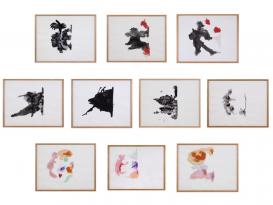In 1921, Hermann Rorschach (1884–1922) published Psychodiagnostik. Methodik und Ergebnisse eines Wahrnehmungsdiagnostischen Experimentes (Deutenlassen von Zufallsformen), a 174-page text accompanied by a set of ten plates of his own design—five in gray-scale, two in gray-scale with red, and three with four or more colors. Seventy years later, Rosemarie Trockel (b. 1952) exhibited five untitled Wollbilder or Strickbilder (wool-pictures or knitted-pictures) whose 250 x 160 cm navy-blue and beige-gray surfaces allude in various ways to the ten plates of Rorschach’s experiment in the interpretation of arbitrary or chance forms. In 1992, Trockel continued her exploration of the Rorschach plates in a set of ten works in ink and watercolor on paper, Ein zum Leben Verurteilter ist entflohen (a title that alludes, by means of the presentation or staging of an association, to the title of Robert Bresson’s 1956 film Un condamné à mort s’est échappé), and in two additional untitled Wollbilder that expand her inquiry into the dynamics of perception and interpretation in Rorschach’s experiment. Trockel’s large-scale Rorschach-Bilder also relate to some very large 1984 paintings by Andy Warhol that took as their point of departure what Warhol knew, and what he claimed not to know, of the “Rorschach Test” as a test of personality widely referenced in US popular culture beginning in the mid-1940s. Trockel’s works, unlike Warhol’s, address a central problem in Rorschach’s original experiment: the conceptualization of interpretation as a “special kind of perception.” Her Rorschach-Bilder exemplify the depth and complexity of the artist’s engagements with modernism and its aftermath in art, literature, and film, and with late nineteenth/early twentieth-century philosophy, psychology, and psychoanalysis, in particular the work of Mach, Freud, and Wittgenstein.

Trockel, Ein zum Leben Verurteilter ist entflohen (1993) © Courtesy of Sprüth Magers.
Project
(2019-2020)
